
Houses in Aristi, most with natural stone shingles on the roof. (1287k)
From the Zagori entry in Wikipedia:
Zagori is a region and a municipality in the Pindus mountains in Epirus, in northwestern Greece. The seat of the municipality is the village Asprangeloi. It has an area of some 1,000 square kilometers and contains 46 villages known as Zagori villages (or Zagorochoria or Zagorohoria), and is in the shape of an upturned equilateral triangle. Ioannina, the provincial capital, is at the southern point of the triangle, while the south-western side is formed by Mount Mitsikeli (1,810 m (5,940 ft)). The Aoös river running north of Mount Tymphe forms the northern boundary, while the south-eastern side runs along the Varda river to Mount Mavrovouni (2,100 m (6,890 ft)) near Metsovo.
The region has been historically difficult to access due to its mountainous terrain which likely contributed to its unique character. The Sarakatsani people who can be found in this area use several Greek words of a Northern Greek dialect not commonly found in Greek elsewhere. They are consequently considered by some as indigenous to the area.
The first evidence of human presence in the area is dated between 17,000 and 10,000 years ago. Important epipaleolithic artifacts have been unearthed from Kleidi Cave on the banks of Voidomatis. In antiquity, the region of Zagori was inhabited by the Tymphaeans and formed a part of the ancient kingdom of the Molossians, a Greek tribe of Epirus that gained control over all of Epirus in classical times. The Molossian royal house ruled Epirus from the ancient town of "Molossis" which was located near modern Konitsa, in the northern boundary of Zagori, where the rivers Voidomatis, Aoös and Sarantaporos come together. The Molossians were known among else for a breed of great mastiffs they used to guard their flocks from wolves and bears and which were even used in war. Molossus, their eponymous ancestor, was said to have been born of a union between Neoptolemus (son of Achilles ) and Andromache (the wife of Hector of Troy). Neoptolemus, also called Pyrrhus for his blond hair, was first in a line of Epirotan kings leading to the king Pyrrhus of Hellenistic times who launched several campaigns against the Romans in Italy. Olympias, the mother of Alexander the Great, was a Molossian princess. Remains of cyclopean walls in Skamneli also testify to the antiquity of human occupation. During the 9th–4th centuries BCE, a small Molossian settlement existed between Monodendri and Vitsa, including stone houses and two cemeteries which have yielded important findings. Additionally, foundations of fortifications and graves from the Hellenistic period have been found in Skamneli. However, throughout most of the historical time the local population was sparse.
The passage of the Slavs during the early Byzantine period is testified to by numerous placenames. The placename "Zagori" itself is probably derived from the Slavic Zagore meaning "beyond the mountains". Under the Byzantine Empire, Zagori occasionally attracted groups of soldiers who built villages and settled there. Several monasteries were royal endowments, including the monastery of Votsa near the village of Greveniti and the monastery of the Transfiguration near Kleidonia, founded in the 7th century by the Byzantine Emperor Constantine IV Pogonatus and the monastery of St John of Rogovou near Tsepelovo founded in 1028 by the sister of Emperor Romanos III Argyros.
From 1204 to 1337 the region was part of the Despotate of Epirus. In the 14th century, when various Albanian clans made incursions into Epirus, Zagori was the source of soldiers that served in the Ioannina garrison. In turn, as the center of Greek rule, Ioannina shielded Zagori against Albanian attacks. As a result of the campaigns of Andronikos III Paleologos in 1337, the Despotate of Epirus and, therefore, Zagori along with Ioannina and the surrounding region came again briefly under Byzantine rule.
The region came under Serbian rule in 1348 and the Despotate of Epirus was reformed and was under Latin rule by Carlo II Tocco when Ioannina and Zagori fell to the Turks in 1430, at the time of Sultan Murad II. Zagori (which then only consisted of 14 villages) «bowed the knee», which meant in practice that there were obligations between delegations of the two sides and a sum in tax was agreed upon in exchange for very considerable privileges: autonomy, administrative independence, and a ban on Turks crossing the borders into the area.
The Zagorisian League or Koinon of the Zagorisians was formed after the treaty of 1431 with Sinan-Pasha. At that point the arrangement that granted local autonomy was called “Voiniko”. The autonomy guaranteed non-interference in the local affairs by the Ottoman overlords. Zagorisians had their affairs entrusted to a Council of Elders called Demogerontia, headed by a president or governor called Vekylis. As part of the treaty they maintained a force of Sipahi cavalry, with each village contributing a number of horsemen to that force according to its means. The villages of Eastern Zagori, inhabited by Aromanian Vlachs, entered the Treaty in 1480. Many toponyms in northern and eastern Zagori that have Aromanian etymology, while toponyms with mainly Greek or Slavic etymology are present in western and southern Zagori. In a 1986 study of 3546 local toponyms ~70% are mediated via Greek and ~30% via non-Greek languages in their modern form: 13% Aromanian, 8.3% Slavic, 5.2% Albanian and 2.2% Turkish, while in terms of linguistic origin 56% Greek, and about non-Greek (including loanwords that were already incorporated in the local Greek language): 14% Aromanian, 11.5% Slavic, 6% Albanian, 4.8% Turkish, 3.3% of mixed linguistic origin and 2.5% Latin.
Nevertheless, Zagori retained much of its Greek character through its system of government and the benefactions of its expatriates that favored Greek education. The Koinon of the Zagorisians was reformalized by a treaty signed in 1670, under which Zagori enjoyed considerable privileges called Surutia, which were only rescinded fully by the Sultan in 1868. This solution suited the conquerors and the conquered, as it added statutory rules to the geographical factors which had made Zagori a natural refuge. Consequently, Zagori was never broken up to be shared out among Turkish landowners. Its economy flourished thanks to expatriate merchants active in România, Ukraine, Russia and Constantinople, who through remittances to their families and numerous benefactions contributed to the relative prosperity Zagori enjoyed during the period of Turkish rule. Schools for boys and from the 18th C onwards also for girls were built, in addition to watermills to grind the corn as well as new churches, while the water wells were often decorated with ornamental fountains.
In the 17th century, the villages of Western Zagori were also admitted to the Treaty, so that by 1678 the total number of villages in Zagori had increased to 60. Traditional medicine flourished in the form of “Vikos doctors”, who gathered herbs for their preparations from the Vikos gorge. The growing prosperity, aided by privileges obtained by Phanariotes of Zagorisian descent and benefactions from expatriates, allowed the building of several schools, some still surviving, for example the Common School of Greek Studies in Monodendri built by the brothers Manthos and Georgios Rizaris (1835). The brothers also funded the building of the Rizareios Ecclesiastical School in Athens (1844), while Zagori itself was under full Ottoman rule. The brothers Ioannis and Demetrios Anagnostopoulos from Dilofo founded the Anagnostopouleios in their home village and contributed to the expenses for the Zosimaia School in Ioannina. Michael Anagnostopoulos from Papingo built the Kallineios School in Papingo and the Anagnostopouleios School in Konitsa. As a result of the numerous schools, the Greek language was preserved in the area.
As the mountains were outside the direct rule of the Ottoman Empire, they offered a haven for Greeks on the run from the Ottoman authorities. Several prominent scholars of the Greek Enlightenment, such as Neofytos Doukas, Georgios Gennadios and Athanasios Psalidas sought refuge here, after the Sultan's army destroyed Ioannina in 1820. Some among them even made plans to set up a university in the monastery of St John of Rogovou, near Tsepelovo. In 1820, after the rebellion of Ali Pasha, a Turkish force of 1500 under Ismael Pasha arrived in Zagori, part of the total army of 20,000 sent against Ali Pasha. Alexis Noutsos from Kapesovo, a member of the Philike Hetairia, was in command of the force opposing Ismael Pasha. However, the Sultan's armies prevailed. Ismael Pasha removed most privileges other than the right to appoint a local governor (Vekylis), whose powers however became nominal. Ismael Pasha introduced very heavy taxation, amounting to 250 silver coins per person and additional taxation in kind. Zagori was liberated in 1913 during the Balkan Wars.
More than 160 arched bridges were built in the greater area of Zagori, many of which still stand helping travelers to cross the numerous rivers and streams of the region. They were mostly built during the 18th and 19th centuries by local master craftsmen using local stone. These bridges usually have one to three arches called "kamares" in Greek. One of the most iconic is the three arched bridge of Plakidas, also known as Kalogeriko, near the village of Kipoi.
The Vikos Gorge or Vikos Canyon at the heart of the Vikos–Aoös National Park, is the most impressive natural feature of the region. A seasonal river runs through the Vikos Gorge which is about 38 km (24 miles) long. The deepest part of the gorge is about 12 km (7 miles) long. In the middle of its main part, far from road access or villages, it is traversed by Megas Lakkos, an equally deep secondary gorge. The Voidomatis river has its source in the Vikos Gorge and then continues to flow through its own smaller gorge into the river Aoös. The Vikos Gorge at 990 m (3,250 ft) deep near Monodendri while Mt Tymphe, in which it lies, is 1,350 m (4,430 ft) at its highest peak. It is one of the deepest gorges in the world, indeed the deepest in proportion to its width. The Vikos Gorge is also a site of major scientific interest, because it is in an almost pristine natural condition, untouched by human activity. It is a haven for endangered species and contains many and varied ecosystems.
All pictures are © Dr. Günther Eichhorn, unless otherwise noted.











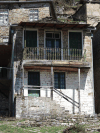


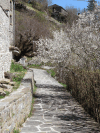

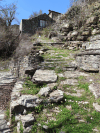



The Zagori region is famous for the many arched stone bridges. More than 160 arched bridges were built in the greater area of Zagori, many of which still stand helping travelers to cross the numerous rivers and streams of the region. They were mostly built during the 18th and 19th centuries by local master craftsmen using local stone. According to my guide there are 47 of these bridges standing.

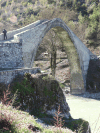












The Monastery of Saint Paraskevi is an abandoned monastery situated on the edge of Vikos Gorge, in the region of Zagori (Ioannina regional unit), northwestern Greece. The monastery founded at 1413–1414, consists of a small stone-built chapel, the oldest preserved in Zagori, and offers panoramic views to the gorge.
The monastery, named after Saint Paraskevi was founded at 1413–1414. According to an inscription over its gate, the foundation took place when the local ruler of Epirus was Despot Carlo I Tocco. It was built by the inhabitants of the nearby village of Vitsa and with the personal expense of a local lord, the voevoda Michael Therianos. Tradition mentions that Therianos built the monastery as an act of thanksgiving for his daughter's savior suffering from an incurable illness.
The church is a small basilica, with only a nave and a wooden roof, surrounded by the monks' cells. The frescoes of the temple partially date to 15th century. On the northern wall, there is a donor portrait of Therianos, his wife and children. The depictions are indicative of the dressing code of that time. The outfits of the benefactors are luxurious with rich embroidered cloths, broad braids and fringes. His daughter, Theodora, is wearing a white kerchief on her head, which is wrapped around her neck. The wall paintings on the south wall are dated from the relevant inscription around 1689.

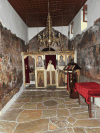


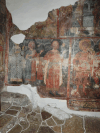

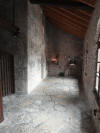

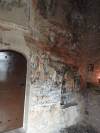






This page contains 49 pictures
Here are the links to the other main pages on Greece:
Page last updated on Fri Jul 8 19:17:14 2022 (Mountain Standard Time)